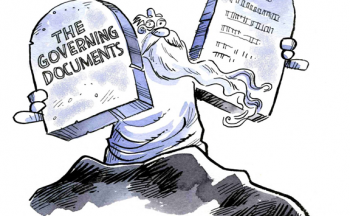 November 2024
November 2024
When my wife and I moved into our condo three years ago it didn’t take long for the 300+ person community to discover that I was a retired Professional Engineer with a background in Facility Management.

I had been an Assistant Vice President of an Ontario University’s Facility Department for ten years and had a similar role at a major Ontario hospital for five years. I knew buildings and the challenges in operating and maintaining them. Hey presto, first Annual General Meeting (AGM) I was elected to the board and immediately asked to serve as President. Does deer in the headlights spring to mind?
I could write a book or two on designing, building and managing buildings but first let me look at the life and times of a typical “director” in our building. I did some historical digging into who we are.
Our condominium corporation is a 218 unit, 28-storey building built in 1979. Over those 45 years there have been 95 owners who have served on the seven-person board. Of those 95 people 42 percent completed just one year; 61 percent completed two years and the average lifespan of a director was just over three years.
Moral of the story – people don’t stick around. There were a few outliers. The longest serving director stuck around for 18 years in various capacities. One did 13 years but never took the role of an officer, just a rank-and-file board member.
Delving deeper into the roll call of names it soon became obvious that once bitten twice shy seemed to be the way things panned out around here. We have a lot of ‘retired’ directors still living in the building many years after they had done their stint, but they seldom came back for a second kick of the can. Many a sad story to tell.
- “I couldn’t stand the constant abuse from owners”
- “I never truly understood what was going on”
- “One (or more) of my fellow directors just dominated and abused the other directors”
- “Too much churn with the condominium manager(s) and superintendents”
- “Took far too much of my time”
I have heard these reasons and more in private conversations with a lot of previous board members.
When we were canvassing for owners to put their names forward to join the board many long-term residents flatly refused. They had seen first-hand the vitriolic abuse many board members had succumbed to. I was first ‘elected’ by acclamation when we only had six nominations for seven positions. Owners don’t come forward. “Volunteerism” is dying across all social groups and gatherings.
What is immediately obvious looking at this historical roll call is that boards attract ‘new’ owners. Either they naively want to help and get involved, or see what they deem to be incompetence and want to get on the board to “put things right” (which is code for getting people to do things my way!) The autocratic ‘vengeance-is-mine’ types don’t last long.
I have been in our building for three years and am now the most ‘senior’ director on the board. Five (out of six) of the current board moved in after we did. The directors are, with one exception, all newbies.
I get the distinct impression this may be the ‘norm’ at other condos. New owners move in; get on the board; hate it and get off as soon as they can never to return. We even had one director who after two years in the building got on the board and found the whole condo industry so awful she put her unit up for sale and returned to a single-family home.
So, what is wrong with the condo industry?
1. I was surprised when I contacted the Condominium Authority of Ontario (CAO) asking about condo metrics and data to learn just how little information they actually collect. With something like 11,000 condominium units under their watchful eye they had no statistics on the percentage fee increase year-over-year. How many condominium corporations imposed a special assessment and for how much? What percentage of condo fees go into the reserve funds? This is just the start of what should actually be known but for which the CAO, and the entire condominium industry, is blissfully ignorant.
Data as we are all told is ‘gold’. Big technology companies (Meta, Amazon, Apple, Google, etc.) crave and collect our data. Where is the CAO data? CAO doesn’t ask for it; they should.
2. Our building is 45 years old and was not subject for the first 20+ years of its life to the Condo Act so we have been playing catch up for years. However, why do the CAO set the reserve fund contribution at ten percent for the first year of operation? Ridiculously low. It only sets in motion problems down the road when it must be increased substantially. No wonder owners become disgruntled.
Our reserve fund contribution is now at 34 percent of our total revenues and we are in the midst of a three-year $2.7 million series of special assessments!
As one condo lawyer said to me at a conference (who incidentally lived in a condo and had served on his condo board) “don’t buy a new condo; wait at least three years and then move out around year 15 before the financial problems start to accumulate”. Wise words.
3. The CAO, as the government ‘enforcer’ of the Condo Act should establish some basic parameters around how condominium corporations structure the reserve fund study. A triannual study is totally inadequate. Our building has an insured value approaching $100M yet we only have to, under the Condo Act, employ a professional engineer every three years to review the life cycles of all the components and sub-components. There are over 180 such components in our building. The CAO should develop a standard component template that ALL condominium corporations must adhere to and submit annually to the CAO. The Professional Engineers of Ontario (PEO) have already developed such a standard component template. It just needs to be made mandatory for all reserve fund studies to follow this format. This data once collected and submitted to the CAO would be priceless.
Developers of new condominium buildings should also be compelled to supply, as part of the handover of record drawings, a reserve fund template populated with a detailed breakdown of the components of the building but most importantly what those components originally cost. It should also project out the capital costs over 30 years based on anticipated lifecycle data. The reserve fund studies could then be revised and updated based on the ‘modelled’ plan as the building ages.
Condominium corporations must develop a strong relationship with a reputable multi-disciplinary consultancy engineering firm who annually updates the reserve fund study plan based on what they find and what has actually been spent. It incorporates all problems that have occurred or been noted over the past 12 months. Yes, this is more expensive than a cursory review every third year but you get what you pay for. The building is your biggest asset and needs taking care of.
4. In the three years we have lived in our building we have had three property management companies; four condominium managers; and five superintendents. Our corporate ‘history’ is almost non-existent.
Owners sit at the very heart of the condominium business. Are we getting value for the money we pay? We are surrounded (circled?) by engineers, lawyers, accountants and property management firms (never mind the contractors and suppliers). What is sadly lacking is what can best be described as a knowledgeable devil’s advocate for the board and owners. In theory that should be the condominium manager and property management firm, but they are generalists at best. They do not possess specific expertise in any of the other professional disciplines that dictate our life and expenditures whereby they can challenge or question any of the ‘advice’ they relay to the board. They all too often take the view – “we did our job; we got an engineer to do a reserve fund study and they said spend X million dollars”. This “don’t shoot the messenger” reply is a sad reflection on their role.
I appreciate the property management industry is in trouble right now with a lot of retirements plus trouble recruiting new people to the industry but it needs to get a lot more professional, and soon.
One of my fellow directors whenever we are discussing an issue that an owner doesn’t like or takes exception to has a saying “that’s condo living for you”. The typical condo owner has no idea of what they are signing up for when they buy a unit.
John Wordley is President of CCC169 in Ottawa








